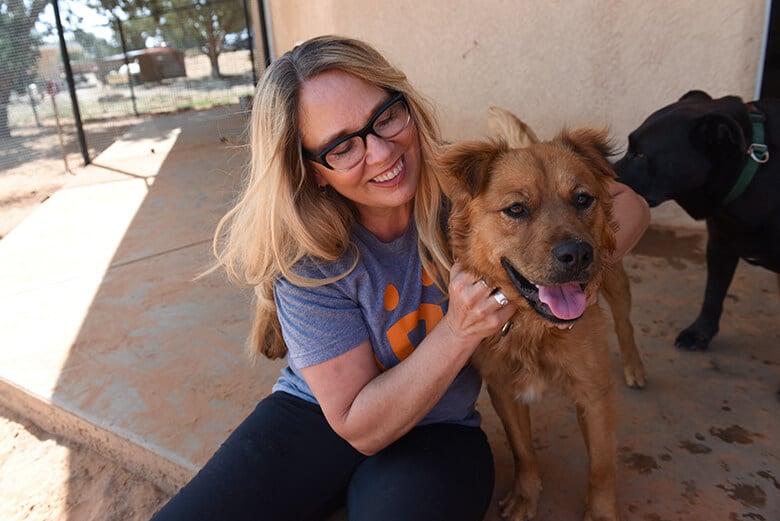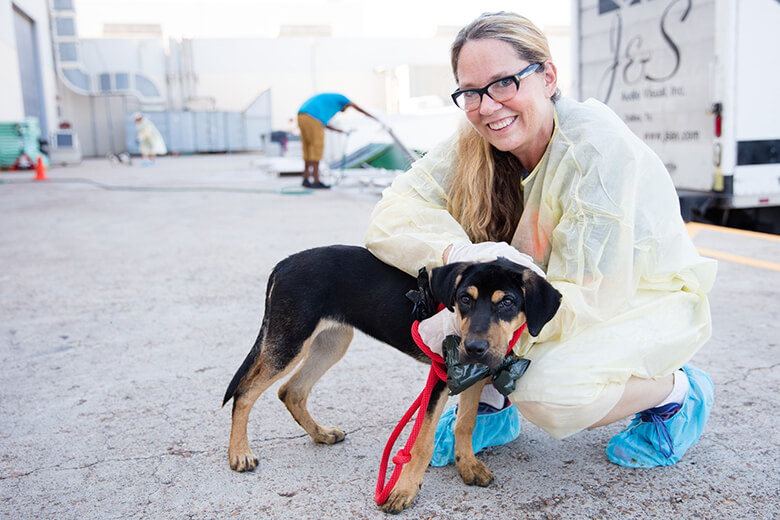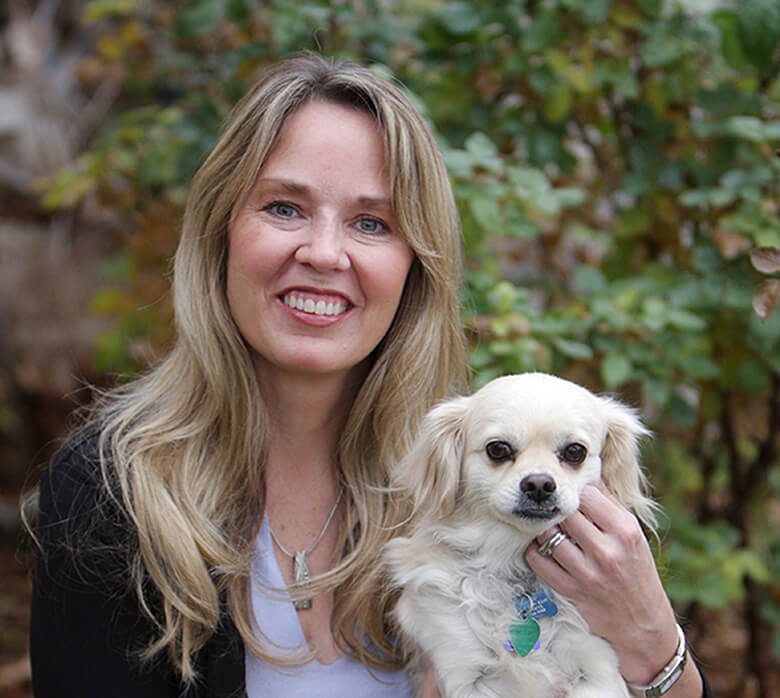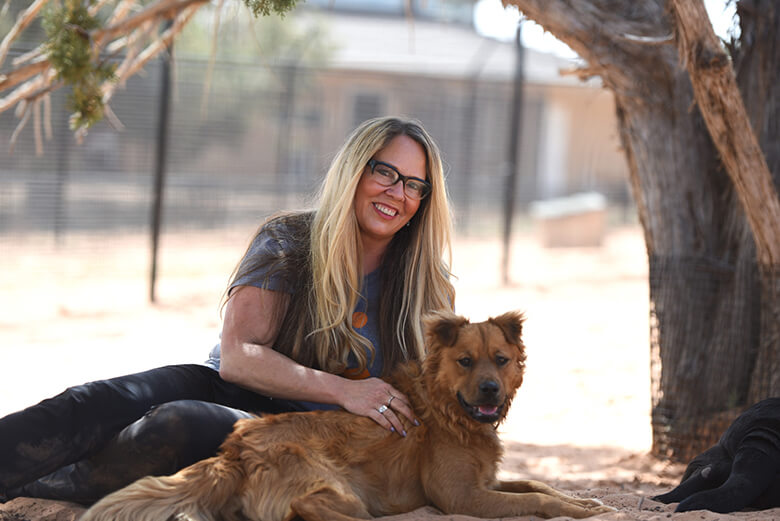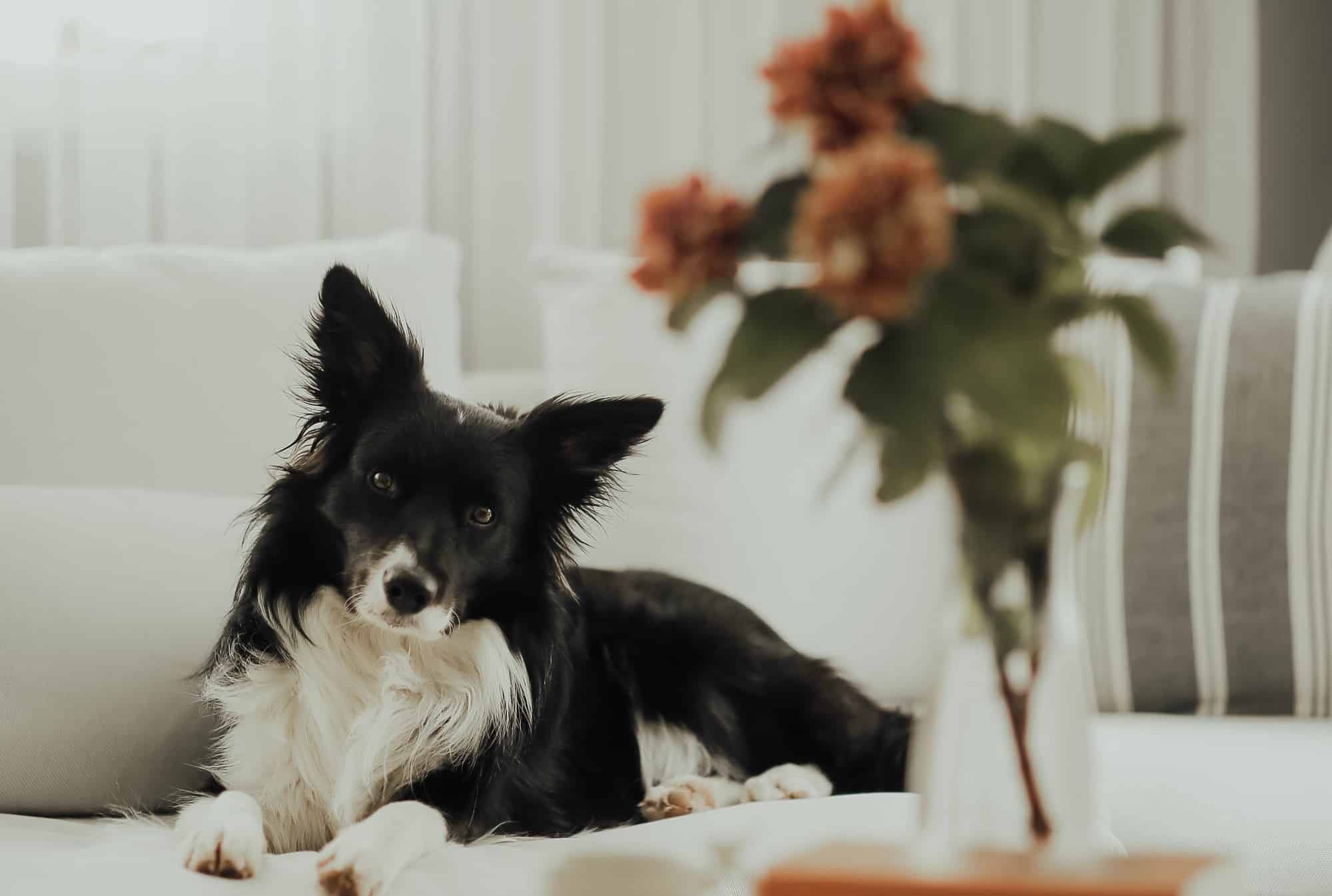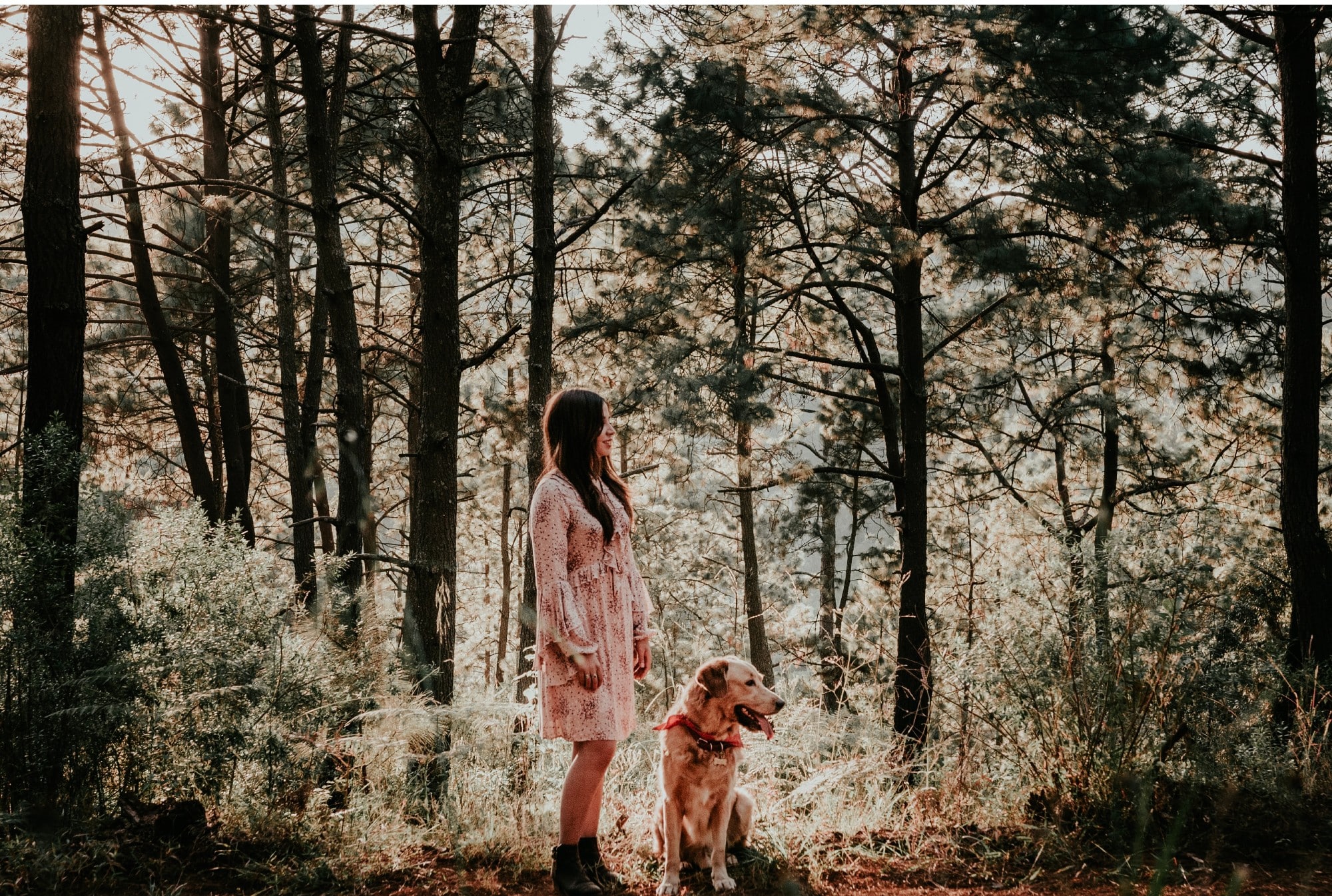It was 1992. Bound for law school, Julie Castle and her friends were driving back from a trip to Mexico in her 1979 Dodge Colt, celebrating one last girls’ trip before having to buckle down and get serious about their futures, life threw them a curveball. With the gas gauge needle buried below empty and the Colt running on its last fumes, inevitability set in: the car stalled.
With barely enough money for gas and a candy bar for each, Castle and her friends were ready to get home to Salt Lake City, Utah. But not before a detour.
“One on my friends was like, ‘I am sponsoring an animal at this sanctuary in Kanab, Utah and really want to stop there,’” Castle recalls. “We all vetoed it. She kept bringing it up and bringing it up, and finally we caved.”
Arriving at Best Friends Animal Sanctuary, now one of the largest animal organizations and known for its “save them all” mission, was a pivotal moment for Castle.
“We pulled in, and it was life changing,” she says.
A lifelong animal lover, Castle fell in love with the founders’ principles and their mission to alter the destiny of homeless animals.
“It has been the same routine for 120 years of basically rounding up animals and taking them to a shelter where they die,” says Castle. “They said it is time to change the narrative around this and talk about a vision where one day we don’t have to do that anymore, where one day the euthanizing of an animal in a shelter isn’t part of somebody’s job description.”
She was sold and decided right then and there she wasn’t going to law school. Castle moved to Kanab and became employee No. 17 at BFAS.
Little did she know, she would be leading one of the biggest movements in the animal-welfare community 25 years later.
In the mid-80s, when Best Friends Animal Society launched, approximately 17 million pets were being killed annually each year, according to the organization.
Today, that number is at 1.4 million, or 30 percent of the 6.9 million animals that annually enter the shelter system.
But for Castle that isn’t a victory; it’s a challenge. With more cities becoming no-kill, or below a 10 percent euthanasia rate, Castle and team wanted the mission to go nationwide.
Recently taking the helm as the organization’s new CEO in March, Castle has her sights set on 2025 to make this dream into a reality.
“At our 2016 National Conference, we decided to announce it, and it was like this nuclear bomb went off in the movement,” she says.
Related: An Inside Look on What It Is Really Like to Be an Animal Cruelty Investigator
Despite it being considered admirable and endorsed by many, some critics, including a recent op-ed in the New York Times, “Are We Loving Shelter Dogs to Death,” state that this initiative is not correctly addressing the issue and the no-fee or low adoption rates put animals in harm’s way by being adopted to families not equipped to care for them. There have also been agreements made that animals can psychologically deteriorate waiting months (or even years) in a shelter to be adopted, the impact on an animal from bounced from foster home to foster home with no stability and the fact that some animals may fall into the hands of hoarders.
Castle, along with others in the animal-welfare community, has pushed back on these claims, including in a recent blog post taking on Carol Mithers, the op-ed author of the Times piece.
“She claims that low- and no-cost adoptions open the door to abusers and those so wretchedly poor that they couldn’t possibly do right by their pets. The reality is that multiple studies show no statistical difference in the emotional investment or the care given to pets by families who acquire their pets for free and those who pay normal adoption fees.”
She also wrote, “Remember that low-cost and fee-waived adoptions result in the safe and long-term placement of hundreds of thousands of shelter pets each year. In fact, the fourth annual Clear the Shelters adoption drive, sponsored by NBC- and Telemundo-owned television stations, culminated last Saturday with more than 1,200 shelters participating in dozens of communities across the country. The event resulted in more than 86,800 adoptions, with 24,000 on Saturday alone.”
And this year, the organization hopes to make those adoption figures higher. BFAS is focusing on the seven states — Texas, California, Florida, Georgia, Alabama, Mississippi and Arkansas – that make up 50 percent of the pets euthanized every year, according to Castle..
We caught up with her to talk about leading a fragmented and sometimes combative community, what keeps her motivated and her next moves.
This interview has been edited for clarity and brevity.
The animal welfare world is complicated and can, at times, see things differently. For those looking to build a community, get people to back their vision, movement or mission, what do you recommend?
It takes a thick skin. It takes a sense of urgency and driving towards an end goal. And it also takes a high degree of knowing what the important levers are to pull and focusing on those — and forgetting about all the other stuff.
But the number-one piece of advice is helping people understand that there is a bigger ecosystem to a social problem than just their organization. So, it is taking the whole project, putting it into a strategy and helping them understand what their piece of that strategy puzzle is. It helps them focus on the bigger picture.
What has been a particularly challenging time for you and how did you overcome it?
It’s an ongoing challenge; it’s never over. You are always dealing with people’s emotions or different points of view, or people who are worried that your motives aren’t totally pure.
We have gone through different benchmarks through this process. We had a lot of trouble in the beginning with veterinarians. They were worried that us doing high-volume spay/neuter was going to take away their business. The way we got around that was to do something with them, and so we got the state vet involved. We did a test to see if the clientele was going to be the clientele that goes to a vet, and sure enough, it was low-income folks that needed that help and assistance and likely would not have gone to a veterinarian for a spay/neuter surgery.
You need to really focus on building those relationships, versus it being transactional, or having it look like just a win for your cause.
It is hard. It is one of the most frustrating things but also one of the most rewarding, because you know where you want to go. You know what your finish line is. I have learned it is never going to end up like you think it is going to end up, and you have to be okay with that as long it is achieving that collective impact.
You need to listen and understand other points of view and then design a solution together.
During pivotal shifts and complicated times, mentors are often great to lean on. Early on, you made a huge move from law school bound to working in the animal welfare community. Did you need to rely on mentors?
I don’t think any of us get anywhere without help from a community of people. It’s important that you identify that you can’t do alone. I have had several mentors along the way.
The key with mentors is when they give you advice, listen. They have been there before. I think if you can understand that, there is a huge benefit to that.
Related: The 4 Things You Can Do to Fight Back Against the USDA’s Removal of Animal Welfare Data
Are you a mentor now?
If people reach out and ask for my advice, I always try and make time for them, because you are just building that next circle of influencers.
It is so critical to be vulnerable and open and share your shortcomings and where you are having success.
One of your earlier positions at Best Friends was in marketing and communications, what tactics did you use to build the brand, and do you still use them today?
It is all about telling that story, and to us, storytelling is the most powerful, most important tenant in communication and marketing, because the human brain is hardwired to understand stories.
Another tenant we live by is being positive, and so all our messaging and all of our photographs are positive. You will never see a horrific picture of an animal from us, and it’s because at the end of the day, people gravitate towards [positivity] more.
What has been your most successful campaign and what can people learn from your success?
Our most successful campaign has been our no-kill efforts. The lesson we learned and the lesson I would impart on others is that it takes a community to be sustainable. If you are going to change society, it needs to be a collective effort, because one organization can’t bear the brunt of making that happen. This is why I believe in coalitions; it takes a community to change a community.
Related: Best Friends Animal Society Unveils Its No-Kill Shelter in New York City
You recently become the CEO earlier this year. What advice do you have for people taking over the leadership of a company?
I think every company has problems. A company is made up of human beings and human beings are complex — nobody is perfect, and no company is perfect. That is step one: being real where you are and where your company is. For me, it was important to do a listening tour, and I don’t mean just go around and shake people’s hand and stop in, but to actually volunteer and do some of the jobs. The staff opened up and started talking about their challenges and some situational problem they had. From that, three themes emerged for us. I pulled in our senior leadership team and said here are the three things we need to fix. We designed a whole reorg chart, which is going to be really healthy.
So, the best thing you can do is listen. Take time to listen to your staff, because they have the answers.
You learn on the job, but you also learn by educating yourself. Is there any book you rely on for leadership?
Part of leadership is understanding where you want to go and why. It’s about finding your grand passion as soon as possible in life and then going full throttle to put your passion behind that effort. It’s also about understanding emotional intelligence around the people you’re responsible for leading, not just as their place or part in the organization or movement you’re leading, but also helping them get through life. It’s about creating a culture of humanity and recognizing that life is really hard and part of your responsibility as a leader is helping meet their life needs, while at the same time mobilizing them to be all in and inspired about the work they do.
So, for me, the three books that have helped me with the “why”— the discovering of an employee’s grand passion and truly understanding emotional intelligence — are The Alchemist, Start With Why and Primal Leadership.
Related: Shelters’ ‘Live-or-Die’ Test Is Getting Put Under the Microscope
When you have critics or people who don’t see things your way, how to you forge forward?
Back in 2009, I was diagnosed with an aggressive advanced stage cancer, and I was sent out to UCLA to get treated there. I didn’t know if I was going to live or die, and I was curious how I was going to respond if I did live: was I going to retire and travel the world, or how I would react to this.
When you are staring something like that down, everything becomes a lot clearer in your head, and for me, it was about a sense of urgency to think about every day. You are never going to get that day back, so how are you going to spend it.
You can either push things forward to help make the world a better place, or you can be one of those obstacles that is distracting from the greater good.
For me, being out there in LA, I decided we were going to launch NKLA [no-kill LA], and we are going to make this happen in a challenging community. It’s about a sense of urgency, and it’s about conveying to the folks we are working with that this isn’t a time for us to waste our energy on gigantic blackhole stuff, like infighting. Let’s focus on the solutions and get the job done. Literally, you don’t know what tomorrow is going to bring.
What trait do you rely on most to be successful and leadership?
No fear. Being totally fearless and recognizing that sometimes you need to dig deep and move through that fear to get to where you need to be — and sometimes that means being incredibly uncomfortable. It is hard to dig deep, but it helps so much for relationships and communication.
What is on the horizon for you?
Our big areas of focus are going to be Southern California and Texas. That doesn’t mean to say we aren’t going to be in other parts of the country, but because those are no. 1 and no. 2 states for the killing, we are going to have a huge presence in those states.
Related: USDA Rolls Out ‘Refined’ Animal Welfare Database, Continues to Protect Puppy Mills













